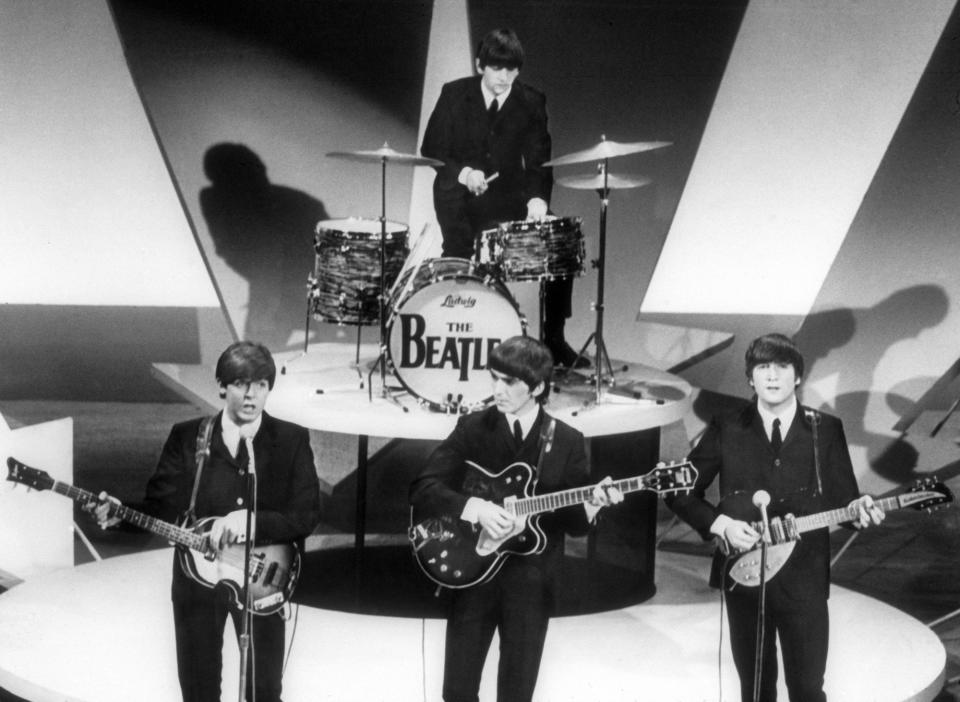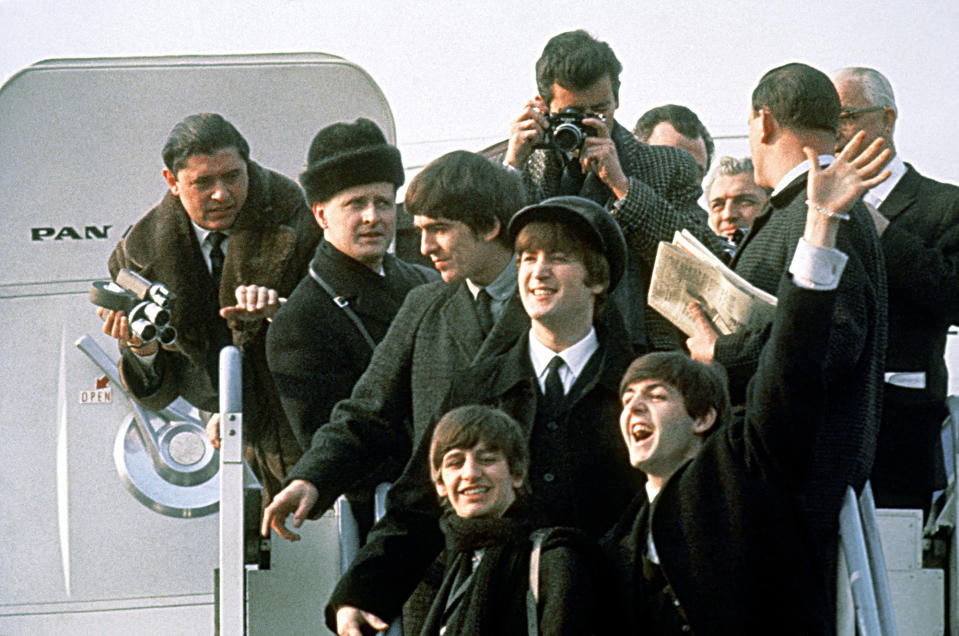Beatlemania in My Life: A Personal Reflection
In those moments when things get tough, or it feels as though the bottom is falling out of the day, it starts to kick in. The knowledge that, for a time, I can make it all oh-so-easily go away. Oh, sure, I’ll resist, but once it starts gnawing away at my mind, I realize it's impossible. In fact, without even being aware of it, I’m actually seeking it out. That sweet instrument of peace; so quick and easy. And before I know it, I’m making it happen. Seconds later, it’s done. The world before me melts away as Beatlemania in my life takes over. I’ve taken a sad song, and made it better.
And not for the first time.
When John Lennon, Paul McCartney, George Harrison, and Ringo Star invaded America in 1964, I wasn’t even four, so suffice to say there was no Beatlemania in my life. Throughout the '60s I was certainly aware of The Beatles, and watched with amusement as my friends freaked out over them, some inspired enough to pick up guitars and start their own bands.
"What a bunch of nerds," I thought, as I adjusted the towel around my neck that was serving as a Superman cape while watching Star Trek.
MUST-READ: Our other articles looking back at The Beatles!

Getty
Rock 'n' Roll Music Changes Everything: Beatlemania in My Life
Yep, I pretty much avoided the whole thing. Forget Sgt. Pepper, pass the salt. When Paul sang, “Let It Be,” I wondered why no one would. I was pretty much oblivious to the whole thing — untilJune 1976. That month, Capitol Records released a double-album (back in the days before everything was digital) called Rock ‘n’ Roll Music, which consisted of The Beatles' original rockers and cover songs.
Additionally, the single released from the album, “Got to Get You Into My Life,” began climbing up the charts, ultimately reaching number seven. At the same time, it was taking me along for the ride — there was just something about that song that blew my 16-year-old mind. Out of curiosity, I picked up the album and lowered the needle of my stereo onto the vinyl, unaware that my life was about to change forever.
MUST-READ: The Beatles White Album Songs — Fascinating Secrets Behind All 30 Tracks
It began with “Twist and Shout” and ended with “Get Back," with 26 songs in between. That was a total of 28 tracks by a band that had broken up six years prior, but whose music was back on the charts — and certainly in my mind.
I needed more, and, fortuitously, I happened to work at a gas station at the time, where there was a guy, whose name has long since faded, that would come in, pop open his trunk and have a variety of things to sell, from records to speakers. Amongst it all was the album Let It Be, which I immediately purchased. While far from their greatest, it was nonetheless a Beatles album and I devoured it as I had Rock ‘n’ Roll Music.
MUST-READ: The Beatles Cartoon — How the Fab Four Came to Saturday Mornings

Getty
On the weekends, my friends and I would take the bus to a nearby town called Patchogue to catch a Saturday afternoon flick, but with my encouragement we made our way to the the record store — Mother's Music (where they'd answer the phone, "Mother's...") — as well. Every week or two, I would pick up another Beatles album, in between hitting the library and starting to read biographies of the band. The seeds for Beatlemania in my life had taken root.

Capitol Records
Flash forward a couple of years and I’m in college, beginning the road to journalism, but still willing to talk Beatles (sometimes imitating their voices... I’m not proud) to anyone willing to engage me in conversation on the subject. There were quite a few, surprisingly.
One afternoon, a guy reached into his bag and pulled out a Beatles album he had picked up during lunch from a nearby store, but it didn’t look like any of the albums I had in my collection. I quietly freaked out. How did I miss this one?
As I began reading the track line-up, with songs like “Soldier of Love” and “Memphis,” he explained that this was a bootleg; a recording made from studio or live tapes that had never been officially released, but managed to work their way into the hands of collectors. And, he said, there were a lot of them.
As bad as I had been with my obsession, things were about to get worse.
MUST-READ: The 10 Most Revealing Beatles' Songs, Reverse Ranked — Including Their Latest Track, 'Now and Then'
Bootleg Beatles: Beatlemania in My Life

YouTube
I’ve never been one of those people who collected memorabilia; someone who had to have anything with a Beatles image or logo on it. My obsession was limited to the music — and especially the songs I didn't have, as in the aforementioned bootlegs. So I went in pursuit of those and spent the next few years buying them whenever I could, lstening to all of it endlessly.
As a teen — and this comes across as no great revelation to many — I oftentimes felt like I just didn’t fit in with many people outside my small circle. I wondered if I’d ever find a girlfriend (I did, and later even found a wife, and together we found some kids) or really connect with other people.

Getty
Not being much of a drinker — college doesn't count, does it? — or having an overwhelming need to use drugs as an escape hatch, what I did find was that no matter how much angst I was feeling, the music of The Beatles somehow listed much of the burden. They were the escape.
By the mid 1980s, I’d entered the work force (first as a clerk and then a PR guy at United Artists Theatres). At the same time, I began freelancing articles about film/TV (my true passion, though you’d never know it from this piece). I’d gotten the whole Beatles thing a bit more under control, until the CD boom happened.
MUST-READ: The Beatles Movies, Reverse Ranked — Plus, a Look at Their Solo Films
The Beatles on CD
Not only was The Beatles' catalog issued in the CD format, but I started reading newspaper articles about hole-in-the-wall record shops that were now selling CDs of Beatles Bootlegs that were different from the ones I had on vinyl. One of those stores — Mr. Cheapo's Record Exchange — was not too far away and I investigated it. Not only did this guy have them, but he had a huge sign that read BEATLES BOOTS, with an arrow pointing down to the bin. I couldn’t believe it.
I began making frequent trips to that store, and I can remember debating with myself about how much of my earnings I could afford to spend on this music. As it turns out, not much, but that didn’t stop me, which caused its own set of headaches that I didn’t stop to think about for long. I needed a fix.

Getty
Yet as bad as that sounds, the Beatlemania in my life didn’t kick in the way that it had just a few years earlier. And I think I can trace the reason for that to December 8, 1980.
I’m a student at Hofstra University, asleep in the dorm. The phone rings at about 11pm and it turns out to be a friend who I hadn’t spoken to in several years, despite being incredibly close at one time. All he asked was, “Have you heard?” I didn’t know what he was talking about and he told me to turn on the TV. I did, and as the black and white screen lit up (couldn’t afford a color set then), there was an image of John Lennon, with the words “1940-1980” emblazoned before it. He was gone, shot to death. Everything went dark.
MUST-READ: Top 12 Badfinger Tunes, Ranked — Sure to Whisk You Back to the 1970s

YouTube
Over the next couple of days, I desperately tried to understand what had happened and, more importantly, why. Now I’m usually fairly upbeat, and have been for most of my life, but I was definitely slipping into a depression. One of my roommates (and decidedly not the president of my fan club), derisively looked at me and snorted, “It’s not like you knew him.” My mind could only retort, “Oh yeah??!!," so it was probably better not to say anything.
I instead tried to go to my usual escape, Beatles music, but it only seemed to make things worse. Later that week, a group of us went into Manhattan to stand amongst thousands of other fans outside the Dakota, John’s home. More sadness.
That Sunday, there was a rally at a nearby park that I couldn’t bring myself to go to. I remember sitting in the common room on the top floor of the dorm, lost in thousands of thoughts, but aware of none of them. And then I saw a New York Daily News headline quoting John’s widow, Yoko One, saying, “Stop the suicides.”

Getty
For me, it was like a slap in the face. Not that my depression ever got me anywhere that low, but I was definitely wallowing in it, embracing rather than shaking off the funk and letting it affect my life. And to know that other people’s obsessions over The Beatles were so strong that they would actually end their own lives than face it without someone who — as my roommate had so compassionately pointed out — they didn’t even know, was just something I couldn’t comprehend.
At that moment, I pulled myself together, went back to my room and started playing a Beatles disc. And then another. As always, they took a very sad song and made it bearable before it got better.
Such is Beatlemania in my life.
Enjoy much more of our stories on the world of Music!
